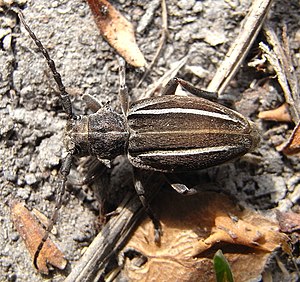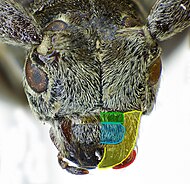Neodorcadion bilineatum
| Neodorcadion bilineatum | ||||||||||||
|---|---|---|---|---|---|---|---|---|---|---|---|---|

Neodorcadion bilineatum |
||||||||||||
| Systematics | ||||||||||||
|
||||||||||||
| Scientific name | ||||||||||||
| Neodorcadion bilineatum | ||||||||||||
| ( Germar , 1824) |
Neodorcadion bilineatum is a beetle from the family of the longhorn beetle and the subfamily Lamiinae . The species name "bilineatum" refers to the two white longitudinal lines on the wing covers. The insect that lives on the ground is at home in south-eastern Europe and radiates from there to Central Europe.
Characteristics of the beetle
The body is roughly oval and reaches a length of 12 to 14 millimeters. The body is black, but appears unevenly gray-brown because of the tomentation .
The head is inclined downwards perpendicular to the body axis. The mouthparts point downwards. The last link of the jaw button is spindle-shaped (Fig. 4, right red). In contrast to the numerous species of the genus Dorcadion , the front edge of the head shield (Fig. 4, right above the green membrane) is not protruding, it lies in one plane with the base of the mandibles (Fig. 4, right yellow). The eleven-segmented antennae reach about the last third of the wing-coverts, the individual antennae-segments are knotted at the end. The third antenna element is shorter than the first (Fig. 2). The kidney-shaped compound eyes encompass the antenna base from behind. At the apex, the inner edges of the eyes are closer together than the inner edges of the antennae bases (Fig. 3 and taxo picture).
The pronotum is slightly wider than it is long and drawn out on the sides into a pointed hump that points slightly backwards. Like the head, it has a more or less distinct white central band.
The wing covers are matt brown due to the tomentation, each with a clearly separated white longitudinal band. The shoulders are protruding. Two ribs arise at the base of the elytra. The strong shoulder rib runs laterally and extends beyond the middle of the wing cover. The weaker back rib arises on the inner edge of the shoulder, converges slightly to the wing cover seam and runs out quickly.
The legs are very sturdy. The five-limbed tarsi appear only four-limbed (pseudotetramer), because the very small fourth tarsal is hidden between the lobes of the third tarsal.
biology
The species loves warmth. The larvae eat roots from grass and other herbs. They need a year to develop. The beetles appear in spring.
distribution
The distribution area of the southeast European species is not compact. In the west it starts in Italy . However, the species is absent in Austria and Slovenia . The distribution area extends from Croatia via Hungary and Slovakia to the Ukraine , but is absent in Romania . In the south you meet the species in Greece and the countries bordering on it to the north.
Individual evidence
- ↑ a b Neodorcadion bilineatum in Fauna Europaea. Retrieved December 12, 2010
literature
- H. Joy, KW Harde, GA Lohse: The Beetles of Central Europe. Volume 9. Spectrum Akademischer Verlag, Munich 1966, ISBN 3-827-40683-8 .
- Adolf Horion : Faunistics of the Central European Beetles, Bd. XII . Überlingen-Bodensee 1974.



